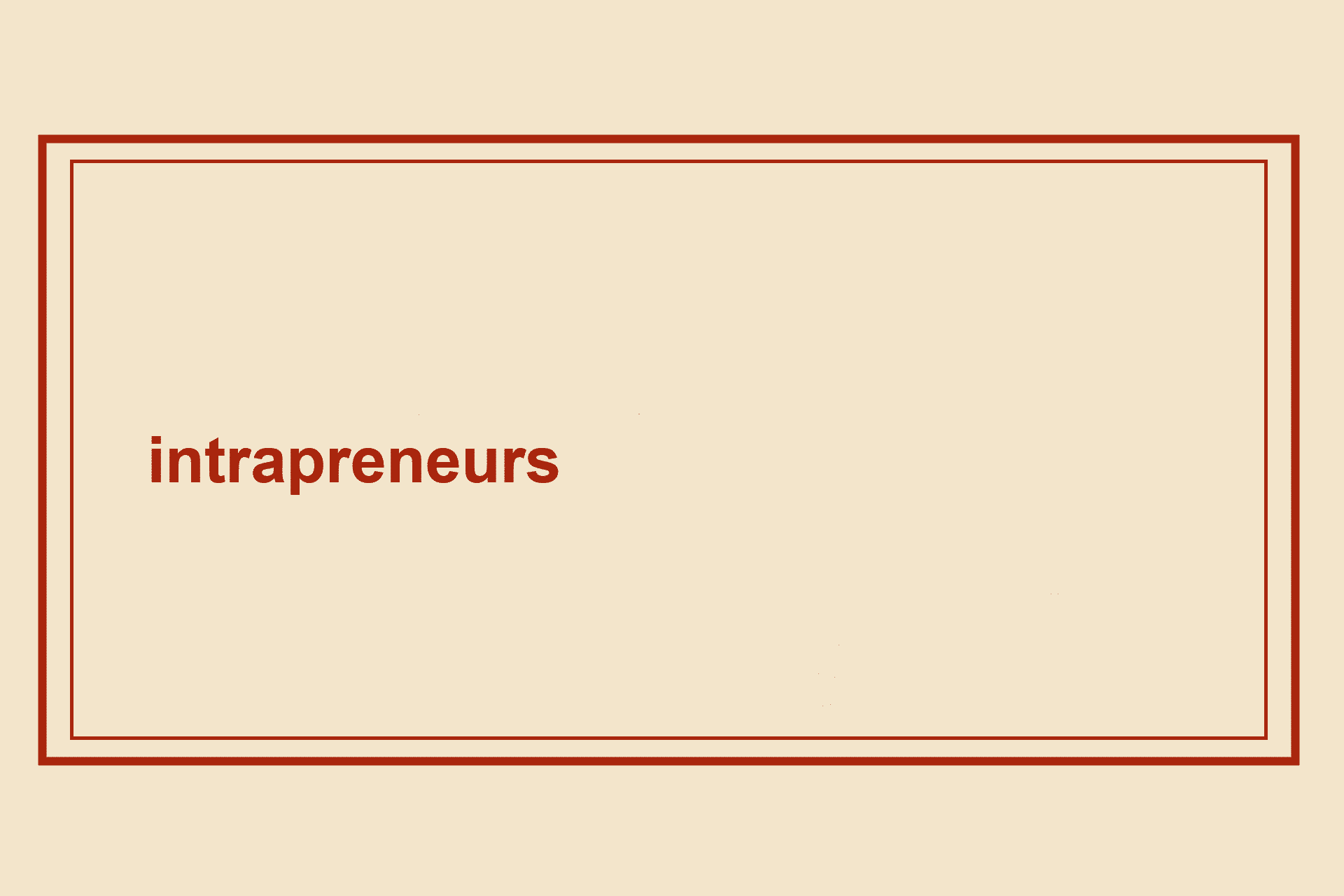Intrapreneurship needs empowerment and ownership
What organisation does not want employees who are proactive, solution-oriented, innovative, committed, independent and motivated? What organisation doesn’t want intrapreneurs as employees?
Richard Branson already stated in an article in 2011: “Virgin could never have grown into the group of more than 200 companies it is now, were it not for a steady stream of intrapreneurs who looked for and developed opportunities, often leading efforts that went against the grain” (1).
Since then, the momentum around intrapreneurship has increased even further. Indeed, organisations are implementing more and more measures to promote intrapreneurship. However, from the organisations’ perspective, one of the biggest challenges remains the implementation of an intrapreneurship mindset. In this article, I would like to discuss how an intrapreneurship mindset can unfold thanks to empowerment and ownership.
What is intrapreneurship?
First, let’s look at what intrapreneurship is exactly, and what makes an intrapreneur stand out.
Gifford Pinchot III, the inventor of intrapreneurship (2) defines an intrapreneur as follows:
“An employee with entrepreneurial spirit who innovates for the benefit of their employer, their own fulfilment, and the wider world” (3).
Intrapreneurs develop innovative ideas in an existing organisation that can lead to new products, services or business areas, or that have an impact on the culture. The main characteristic is that ideas are implemented thanks to intrapreneurs. And that bottom-up, like grass roots.
This means that employees are not only intrapreneurs if they have taken part in corresponding intrapreneurship programmes, they can basically be found everywhere in the organisation. Sabine and Alexander Kluge have introduced numerous such intrapreneurs (grassroots initiators) in their book. (4)
According to Pinchot’s definition, intrapreneurship is first and foremost a “spirit”. But what constitutes this “spirit”, this mindset?
Intrapreneurs are characterised by the fact that they can develop and pursue a vision. They want to implement a solution to a problem. They are what Pinchot calls “dreamers who do”. (2)
They are not only concerned with the growth of the company, but especially with personal development. For example, I perceive intrapreneurs as strongly value-oriented. And I observe that they are willing to take risks. In order to implement ideas, they may act without a mandate, bypass their job description (4) and, as Richard Branson says: “often leading efforts that went against the grain”. Which certainly leads to conflicts.
Interest in and implementation of intrapreneurship is growing
Organisations recognise the potential for increased innovation and agility in intrapreneurship. That is why more and more companies are taking measures to promote intrapreneurship.
Professors Rodrigo Isidor and Matthias Baum from the University of Bayreuth have been running an intrapreneurship monitor since 2020 to “provide an overview of the background, drivers and success effectiveness of intrapreneurship activities in Germany based on scientific analyses, expert interviews and market evaluations.” (5)
For 2022 they state: “This year we can also see an increase in the intrapreneurship activities of German companies (…). There are also more and more in-house intrapreneurship departments.” (5)
In the meantime, companies increasingly expect intrapreneurship skills from applicants, as Dr. Christian Stumpf (intrapreneurship expert and co-founder of TenneT Power Labs, among others) showed in a LinkedIn post based on 7 job offers from large corporations, among others. (6)
But in practical implementation, major challenges remain to be solved. These are:
- Building the intrapreneurship mindset among employees,
- finding employees with this mindset,
- and motivating employees to participate in intrapreneurship measures (5).
Remarkably, according to the Monitor, these challenges have even increased compared to 2021.
How can the intrapreneurship mindset be promoted?
Richard Branson emphasises the role of the organisation. An intrapreneur is: “an employee who is given freedom and financial support (…), who does not have to follow the company’s usual routines or protocols” (1).
We need more empowerment!
“What if CEO stood for “chief enabling officer?” (Richard Branson) (1)
Employee empowerment can take place on a structural and/or psychological level (cf. (7), p. 55ff). Structural empowerment is mainly about a new order of power distribution, e.g. through more co-determination in decision-making. Psychological empowerment, for its part, focuses on people and how they subjectively evaluate and experience their role in the company.
Gretchen M. Spreitzer has defined 4 assessment dimensions of psychological empowerment with her research:
- Competence,
- significance (meaning),
- self-determination and
- influence (8).
The stronger the dimensions are subjectively experienced, the stronger the feeling of empowerment. I like to connect Gretchen Spreitzer’s research with the self-determination theory of Edward L. Deci and Richard M. Ryan and Aaron Antonovsky’s model of salutogenesis.
What happens when people feel empowered? “Our research shows that empowered employees take initiative, engage in transformational change, and are seen to be highly effective. In short, they act like leaders” (Gretchen M. Spreitzer/Robert E. Quinn, (8), p. xvi).
Empowerment thus evokes intrapreneurs.
“Psychological empowerment, however, does not appear out of nowhere, but is influenced by socio-structural conditions (…)”. (Carsten Schermuly, (7), p. 70)
According to Carsten Schermuly, organisations must adopt 7 necessary basic attitudes, such as.
- “People are at the centre of organisational action”,
- “All four facets of psychological empowerment must be taken into account” (here the dimensions mentioned above are meant) or
- “Everyone can be empowered”.
In addition, they must take appropriate measures on work design, leadership and organisational culture, as well as on staff selection and development (7).
Ensuring empowerment, however, can be a challenge for managers. After all, if they do not feel empowered themselves, they cannot empower others. “The more empowerment employees perceive in their leaders, the more they felt empowered themselves!” (Carsten Schermuly, (7), p.187).
Furthermore, allowing freedom for “out of the box” ideas can conflict with adherence to standards or key performance indicators. Leaders therefore need to be able to deal with ambidextry.
But despite the challenges for the organisation and its leaders, it is worthwhile to empower employees, as Gretchen Spreitzer describes it: “Creating a company of leaders – a high performance workplace in which employees willingly do their best work and act as owners of the business – is both strategic advantage and a necessity for attracting and retaining the best people” (Gretchen M. Spreitzer/Robert E. Quinn, (8), p. 25).
With empowerment measures, an organisation can thus promote intrapreneurship.
Employees can also be intrinsically empowered and act like “owners of the business”.
Ownership
“What if companies had belongers rather than employees?” (Richard Branson) (1)
By “belongers”, Richard Branson is referring to the status of residents of British overseas territories (in his case the British Virgin Islands), which is usually reserved for “natives”.
I myself like to use the word ownership. I come across this term more and more often when employees take on responsibility without actually being owners of the company or being authorised or obliged to do so by function in the organisational chart.
What characterises ownership (mindset)?
Nick Leighton described it in an article in Forbes (10). Employees with an ownership mindset also feel responsible for the results of the organisation, they take ownership of tasks and do not need to be assigned, they make decisions, they lead by values rather than rules.
In short: they act as if they were owners.
An example of this is provided by Ronny Grossjohann and Dr. Robert Harms from Siemens, who established an ownership culture in a major project with a lot of courage. With a lot of courage, because in doing so they acted contrary to the usual and accepted procedures (9).
“Independently of all the rules, they asked their project participants how they would tackle the project. From then on, with dialogue, moderation and trust, they steered it to a success that has brought them much attention and several prizes to date. (Sabine Kluge/Alexander Kluge, (4), p.165).
On the one hand, they took ownership of their project and ran it according to their own standards, i.e. they acted as intrapreneurs. On the other hand, they encouraged others to take ownership themselves.
Because the benefits of ownership are obvious:
“If you invest your life energy in a project of your own free will, then there is a completely different spirit behind it. Then you are a partner” (Dr. Robert Harms), (9).
People and teams who take ownership, as I know from my projects, are productive, proactive, creative and innovative. They feel more passion and commitment for the results. And they communicate and collaborate beyond silos (10).
For the organisation, this means: Agility, innovation, engagement and commitment (11).
However, an ownership mindset is a challenge for the organisation: “Because ownership culture also means: admitting decisions that you would have made differently yourself” (Ronny Grossjahn), (9). It means that people take, or at least demand, the freedom to shape things. It means they see their actions as an investment in the company and in themselves. They approach their work with critical and holistic thinking, they question, they weigh.
In short: they are entrepreneurs within the company.
Conclusion: With more empowerment and ownership to more intrapreneurship
So how can the intrapreneurship mindset be established in organisations? A mindset that is proactive, innovative, independent, engaged, self-responsible, intrinsic and committed.
What can the organisation do?
It can empower, i.e. ensure that employees experience competence, self-determination, meaning and influence. In particular, it can reach those employees who are not (yet) confident.
What can the individual do?
Strengthen their own ownership mindset. Intrapreneurs have a strong ownership mindset: they do not wait for the organisation to create the structures. They act even without a mandate, they actively demand better structures or they quit. But many of them do not dare to do so because: “Many of them probably have no idea how much freedom they would have if they would only take it” (Sabine Kluge/Alexander Kluge, (4), p. 186).
I would therefore like to conclude with the appeal of Sabine Kluge and Alexander Kluge:
“We would therefore like to call out to managers as well as potential grassroots initiators: Just try it out!” (Sabine Kluge/Alexander Kluge, (4), p. 193).
Notes (partly in German):
If you like the article or want to discuss it, feel free to share it in your network.
(1) https://www.nbcnews.com/id/wbna41359235
(2) Pinchot, Gifford: Intrapreneuring: Mitarbeiter als Unternehmer, 1988, Gabler, Wiesbaden, ISBN 978-3-322-94468-9
(3) https://intrapreneur.com
(4) Kluge, Sabine/ Kluge, Alexander: Graswurzelinitiativen in Unternehmen: Ohne Auftrag – mit Erfolg!, 2020, Verlag Franz Vahlen GmbH, München, ISBN ePDF: 978 3 8006 6371 2
(5) Prof. Dr. Rodrigo Isidor, Prof. Dr. Matthias Baum, Dr. Sonja Franzke, Dr. Jens Schüler: Intrapreneurship Monitor 2022 Universität Bayreuth – Institut für Entrepreneurship & Innovation, Bayreuth, Download unter https://www.hrm.uni-bayreuth.de/de/Intrapreneurship-Monitor/index.html
(6) LinkedInPost von Dr. Christian Stumpf
(7) Schermuly, Carsten: New Work – Gute Arbeit gestalten, 2021, 3. Auflage, Haufe-Lexware GmbH & Co. KG, Freiburg, ISBN 978-3-648-15003-0
(8) Spreitzer, Gretchen M./ Quinn, Robert E.: A company of leaders: five disciplines for unleashing the power in your workforce, 2001, Jossey-Bass (a Wiley Company), San Francisco. ISBN 0-7879-5583-3
(9) https://newmanagement.haufe.de/strategie/innovation-leadership-bei-siemens-ownership-culture
(10) https://www.forbes.com/councils/forbescoachescouncil/2021/11/22/how-to-cultivate-an-ownership-mindset-in-your-team/
(11) https://www.atlassian.com/blog/leadership/how-leaders-build-ownership-mindset
Guénola Langenberg has published another post on the t2informatik Blog:

Guénola Langenberg
For 21 years, Guénola Langenberg was passionately dedicated to project and process management in the automotive industry in an international context.
Today, as a freelance Agile Coaches and Intrapreneurship Coach, she supports people and organisations in implementing innovations and transformation projects. She is particularly committed to value-oriented and co-creative collaboration in organisations and projects.
